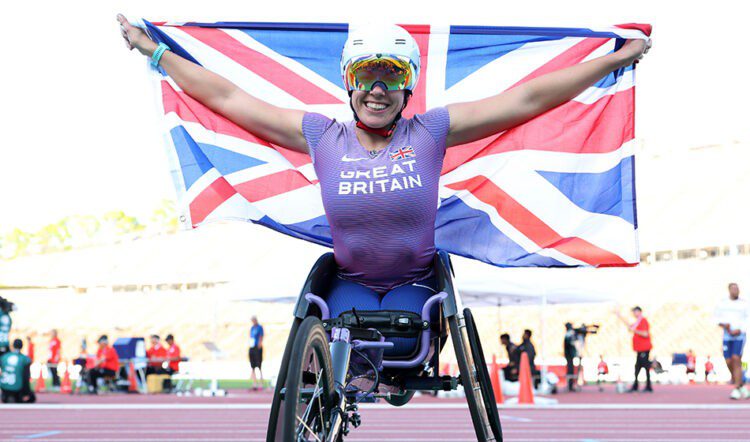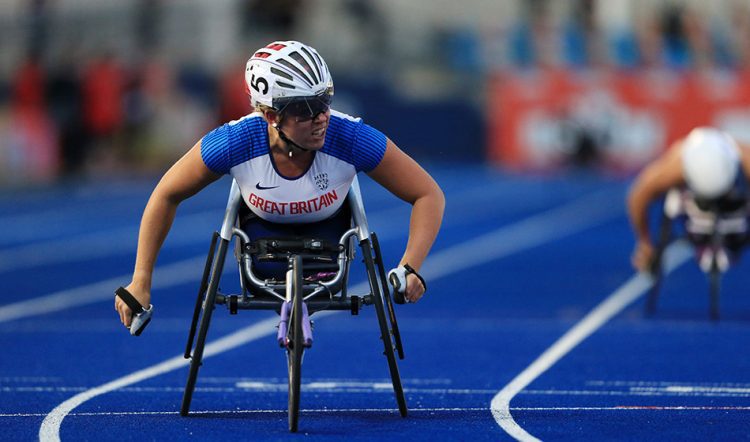Multiple Paralympic champion is no stranger to success but the honours can’t mask the financial difficulties faced by para athletes in pursuing their ambitions
Hannah Cockroft has become used to appearing on podiums. With nine Paralympic gold medals, multiple world titles and established as a dominant force in wheelchair racing for over a decade, she has long been recognised as one of Britain’s most successful para athletes. But there are some honours that still manage to cut through – even for someone with her track record.
Earlier this year, the 32-year-old received a CBE for services to sport. It wasn’t her first trip to Buckingham Palace, having been awarded an OBE after Tokyo 2020. It was also a repeat meeting with Princess Anne, who greeted Cockroft with a knowing smile and a quick comment. “Oh, you’re back again,” said the Princess Royal.
“It was really cool,” Cockroft says. “I got my OBE from her after Tokyo and at the end she was like: ‘Well I think I will see you again, so see you soon’.”
As memorable as the setting was, Cockroft is the first to point out that such accolades aren’t expected or taken for granted – even by someone with a cabinet full of medals.
“People think that you expect to get one, and it’s definitely not like that,” she adds. “You’re not out on the track thinking: ‘I’m going to win gold medals so I can get this recognition.’”
When the letter arrived confirming her CBE, Cockroft called her dad immediately. But beyond the personal joy, she saw something bigger in the award, a rare and needed moment of visibility for disabled people in Britain.
The timing was significant, given the growing unease among disabled communities about proposed government changes to – and eligibility for – the Personal Independence Payment (PIP) system. Over 3.6 million people in England, Wales and Northern Ireland with long-term physical or mental conditions currently receive PIP.
“It’s been such an unsure time,” Cockroft says. “As a Paralympian, you’re not viewed as one of those people that gets the benefit of a PIP…but all the little things that affect disabled people affect us, too. And you can often feel forgotten about.”
Recognition like a CBE, she says, was a small counterbalance, a way of being able to remind people that Paralympians are neither outside, or above, these issues. The reality of para sport remains stark. Since the high of the Paris Paralympics, where Cockroft earned two more gold medals (T34 100m & 800m), she has faced a drop-off in financial support.
“I’ve already lost every sponsor that I had in the Paralympic year,” she says. “We’ve had our funding changed, so we only get one competition a year covered now. [For] everything else, we have to cover ourselves.”

This has had real consequences. Competing internationally is expensive – Cockroft estimates it costs £1000 just to enter a single race at the ParAthletics Grand Prix in Switzerland – and, as someone constantly needing to upgrade performance equipment to remain competitive, the bill keeps rising.
For someone who has dominated her sport for over a decade, that reality stings.
“Name an Olympic champion with no sponsors,” she says. “I can’t name one. And I’ve won nine golds.”
Cockroft admits that this lack of recognition and support weighs heavily – not just for herself, but for what it signals to the next generation of athletes.
“If I can’t afford it, they definitely can’t afford it,” she says. “And that’s where the sport is falling down.”
Since London 2012, often seen as the peak of Paralympic visibility in the UK, para athletics has faced an uphill battle to maintain momentum. Cockroft recalls the post-Games buzz, huge crowds, funding and media attention that felt game-changing. But she also remembers how quickly it faded.
“It’s 10 steps forward in a Paralympic year and then 11 steps back after,” she says. “We’re struggling to get new people into our sport, we’re struggling to open up opportunities.”

Among her biggest concerns is the shrinking number of races and the lack of prize money or professional pathways for para athletes. While the rest of the athletics world debates a change needed for the sport, Cockroft says many para athletes are still fighting for a seat at the table.
“We just want a little piece of what the able-bodied guys have got,” she says.
For Cockroft, the way forward is grassroots. She believes that unless real investment is made in getting disabled children into sport early, the next generation of champions won’t be there. That’s why she has helped to launch a major new partnership between England Athletics, Citroën, and its official charity Personal Best Foundation – bringing after-school athletics clubs to several schools in England.
“These are kids that, for whatever reason, aren’t accessing sport,” says the Personal Best Foundation ambassador and sustainability ambassador for England Athletics. “There’s no financial pressure, there’s no expectation. It literally means that kids get to try a new sport. That’s amazing.”
It’s a mission rooted in her own experience. As a child, Cockroft was excluded from PE lessons due to safety concerns. Her first chance at competitive sport came thanks to a passionate PE teacher in secondary school who helped her find an athletics club.
“Not every child has that support,” she says. “This partnership makes sure they do.”

Despite all the challenges Cockroft has faced, at her side is her husband and fellow wheelchair racer Nathan Maguire, whose recent debut at the London Marathon, where he finished tenth, added a new dimension to their shared sporting life. Cockroft admits she finds it harder watching his races than competing herself.
“He’s still on his way up. I’m just trying to stay at the top,” says Cockroft, whose primary goal for the year ahead is September’s World Para Athletics Championships in New Delhi. “But watching his hunger reminds me why I started. He’s always pushing me to try new things.”










